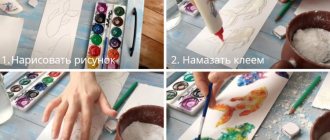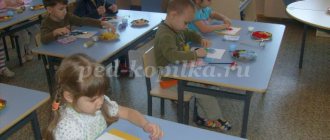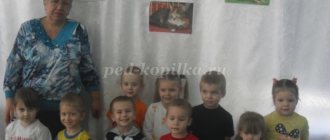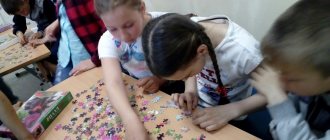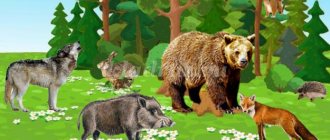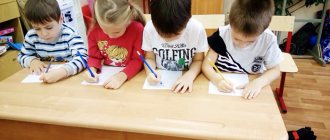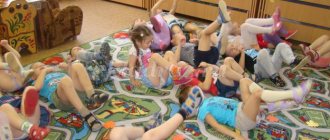On the topic: methodological developments, presentations and notes
Summary of a drawing lesson in the preparatory group. Topic Pets - Drawing a cow.
Topic: “Pet” GCD goal: To consolidate and expand children’s ideas about domestic animals, about the features of their appearance. Continue to develop the ability to think through a compositional picture.
Goal: to introduce children to the life of cats and dogs, to consolidate knowledge about domestic animals; to develop cognitive activity; to cultivate a humane attitude towards animals, a sense of responsibility for those whom they care about.
Goal: Formation of sustainable interest in visual arts. Objectives: Educational: 1. To foster interest in animals of cold countries. Educational: 1. Teach children to use their own.
Synopsis of a lexical and grammatical lesson at a speech center in a preparatory group. Topic: “Pets.” Goals: Correctional and educational: - clarify and expand the active layer.
Summary of educational activities on speech development in the preparatory group. Topic: "Pets." Journey into the fairy tale “How the puppy learned who was most important.”
1. Find out what names of domestic animals and birds our child knows. Look at pictures depicting domestic animals and birds. 2 Explain that these are domestic animals and birds because.
Source
Drawing classes within the theme “Domestic and wild animals”
The topic “Animals” is quite complex and voluminous, so it is advisable to divide the process of studying it into several lessons, which will be evenly distributed throughout the academic year.
Thematic blocks
- “Forest Dwellers” - one of the most popular is the thematic series of drawings “How Animals Winter.” Each animal tells how it prepares for winter: changes the color of its coat, makes preparations (mushrooms, nuts, cones), prepares its home (hollow, den, hole), etc.
- “Pets” will help to form a kind attitude towards pets, reinforce ideas about the peculiarities of their appearance, and teach how to correctly convey in a drawing the body shape, size and pose of the animal’s figure.
- “Animals of Southern Countries” will enrich your horizons with new knowledge about exotic animals, awaken interest in animals and the desire to depict them using various materials and techniques.
- “Animal World of the North” will expand children’s understanding of the animals of the north, the characteristics of their habitat and way of life.
Photo gallery: children's work on different thematic blocks (animals of hot countries, northern animals, our forests)
“Hedgehog in the autumn rain” - combined technique (felt pens and paints)
“Hedgehog Harvesting” - combined technique (wax crayons and paints)
“Donkey” – colored pencils
"Giraffe" - felt-tip pens
“Burenka” - colored pencils
“Carrot for a bunny” - combined technique (colored pencils and watercolors)
“Polar bear” – gouache
“Prickly hedgehog” – wax crayons
“Mustache-striped” – gouache
“Bunny in winter” – felt-tip pen
“Kitten with a ball” - colored pencils
“Shaggy Dog” – gouache
“King of Beasts” – watercolor
“Sister Fox” – watercolor
“Goat” - colored pencils
“Horses” – gouache
“Yard Cat” - combined technique (gouache and wax crayons)
“Hedgehog with hedgehogs” - combined technique (watercolor, wax crayons, felt-tip pens)
"Elephant" - wax crayons
“Giraffes” – watercolor, crayons and markers
“Hippopotamus” – watercolor and colored pencils
Complex large compositions, which are based on a detailed plot and include many different elements, are usually created collectively. The preparatory stage, during which the background is painted over, individual details or figures are drawn, is carried out in small subgroups of 3-4 people, and then the children together compose a plot picture on whatman paper, gluing the silhouettes they have prepared, simultaneously developing spatial thinking abilities, as well as coordinated skills actions. When creating a collective drawing, children are guided by a given condition or design, and the process of collective work itself develops skills of mutual understanding and camaraderie.
Creating a collective composition in a subgroup fosters mutual assistance and camaraderie among children
It is important to pay close attention to the problem of teaching children to understand and follow the correct sequence of work to create a plot composition or collage. The teacher should explain that first you need to prepare a background drawing, painting the entire space of whatman paper, then draw background objects (trees, sun, clouds, houses, flowers, mushrooms, etc.) and only then draw or place previously prepared and cut out silhouettes animal based.
Photo gallery: collective work of preschoolers
“Wintering of forest inhabitants” “Inhabitants of hot countries”
"Beasts in the Autumn Forest"
"Summer Forest"
"Fauna of the North"
Motivating techniques for working with children
During the lesson, it is necessary to include playful moments that stimulate curiosity, cause a positive emotional reaction and activity.
Motivating techniques can be the appearance of a toy character, reliance on a well-known fairy-tale plot, demonstration of pictures, a musical break, a surprise moment, introduction to new knowledge, or the personal artistry of the teacher. It is important to develop the ability to concentrate attention and see an object, to perform its sensory (touch and vision) analysis. The lesson will be interesting if the teacher thinks through the game line of the scenario, taking one of the popular fairy tale plots as a basis.
Table: examples of questions, games, dynamic gymnastics for a lesson on the topic “Wild and Domestic Animals”
| Author and theme of GCD | Contents of the summary fragment |
| Vaganova O. G. “Forest Dwellers” | Game moment
Children, together with the teacher, walk along an imaginary path with the words:
Educator: Guys, here we are in the forest. There are many trees and bushes in this forest, but no animals are visible at all. Guys, look, what is this? There is an envelope under the tree (children's answers). And there is a riddle in the envelope, listen:
The teacher takes it out of the envelope and shows an illustration with a fox. Educator: Really beautiful! Guys, what kind of fox is it? (children's answers). Of course, she has a long fluffy tail, a muzzle that looks like a teardrop, and a sharp nose. We continue our journey (the children and the teacher continue their walk) and approach a birch tree. The teacher finds an envelope under a birch tree, opens it and reads the riddle:
The teacher takes out an illustration with a hare from the envelope. Educator: Guys, what kind of hare? (children’s answers). Indeed, the fur is fluffy, the tail is short, and the ears are long. We continue our journey (the children and their teacher continue their walk). Guys, look, there is an envelope hidden for us here (the teacher opens it and reads the riddle):
Educator: Guys, what kind of bear? (children's answers). Of course, the bear has strong paws, large, but small round ears. The body is large and powerful. We have disenchanted all the animals and now we will show how they move. Physical education minute.
|
| Levochkina T. P. “Drawing polar bears” | Conversation between teacher and children:
|
| Chesnokova O. A. “Travel to distant lands” | Didactic game “Add a word” The teacher names the definition, the children guess what kind of animal it is.
|
Scheme and outline of the lesson
In the preparatory group, standard long-term planning provides for one drawing lesson per week. The total duration of continuous activity should not exceed 25–30 minutes; methodological manuals recommend performing physical exercises (finger, breathing, motor exercises) for 5 minutes for relaxation and prevention of mental and physical fatigue in children.
Lesson outline:
- Organizational part (5 minutes). The information and familiarization stage involves awakening children's interest in the depicted object, studying its shape, color and components.
- Practical part - the teacher explains the sequence of drawing parts of an object, based on a step-by-step scheme for creating an image (5 minutes). Six-year-old children are given more freedom in the drawing process; the pattern is used, as a rule, only in decorative drawing. Demonstration of a picture or sample prepared by the teacher should not be used for copying, but only for the formation of a correct understanding of the task or its clarification. The work is done from life or on the basis of life experience and observation; the basic techniques have already been mastered, and therefore do not require additional demonstration, with the exception of the initial use of new material, for example, sanguine.
- Independent work of children (20–25 minutes).
- The final part - children's images are compared with the object, the degree of similarity between the original and the artistic copy is assessed (3 minutes).
Photo gallery: drawing diagrams of animals (horse, cat, dog, sheep, fox and others)
Rabbit
Goat
Hedgehog
Pig
Squirrel
Horse
running horse
Dog
Monkey
Kitten plays with a ball
Elephant
Cow Giraffe
Fox
Lamb
Cat Camel Leopard
Table: synopsis of GCD on the topic “Domestic animal cow” (author Maltseva I. A.)
| GCD stage | Contents of the stage |
| Goal and tasks | To consolidate and expand children's ideas about pets and the features of their appearance. Learn to draw a cow, continue to develop the ability to think through the compositional construction of an image, continue to learn how to mix paints, develop imagination and memory. Encourage children's initiative and independence when making thematic additions to the work |
| Organizational part | Teacher. People have faithful friends and helpers - pets. Close your eyes. Listen. What did you hear? The audio recording “Voices of Pets” is played or the teacher imitates the voices of animals. 1st child. I heard a dog barking. 2nd child. I heard the cat meow. 3rd child. Like a cow mooing. 4th child. And I heard the horse neigh. 5th child. How a pig grunts, etc. Teacher. Right. Why are these animals called pets? Children. They live next to a person who takes care of them. Teacher: Tell me what a baby cow is called? Children: A baby cow is called a calf. Teacher: What benefits do you think cows bring to people? That's right, they give us milk and meat. People have learned to prepare many healthy, tasty and nutritious foods from milk. |
| Practical part | Teacher: today we will depict a cow walking in a meadow. Let's start drawing with the torso. It looks like an oval. Then we draw a round head. The head has an oval muzzle. On the face there is a nose and mouth. There are also ears and horns on the head. For our cow to see grass, she needs eyes. Now our cow needs to draw legs - at the ends of which there are hooves. Now we need a tail so that our cow can drive away flies. In order for a cow to produce milk, she needs an udder. What a beautiful cow we have! A cow grazes on a wide, green meadow. The warm sun is shining on her from above. Somewhere in the distance, in a village, a kind mistress is waiting for her. |
| Independent work of children | Children draw animals to calm music. The teacher, if necessary, conducts individual work. |
| Final part | Teacher: Now our cows will all gather into a herd. Children hang their work on the board. The teacher asks the child to give a name to his cow and tell what her character is. |
Progress of the lesson.
the group this morning and I read it, do you want to know what was written in it? So my brother and sister, Tanya and Vanya, wrote it to us; they are going to go to the village to visit their grandparents. In the village, grandparents have pets . But Tanya and Vanya's friends had never been to the village and had never seen domestic animals . They ask Tanya and Vanya to bring them photographs of their pets . Tanya and Vanya ask you to help them take photographs.
— Do you want to please Tanya and Vanya’s friends and bring a photo album with photos of pets ?
-Can you do this? But there is one problem: we don’t have a camera. What do you think we can replace photography with? Yes, we just need to draw pets . Who has pets at home , raise your hand? Tell us about them?
(Children talk about their pets )
You and I know that there are
animals that live not in the house itself but on the street, does anyone have such animals ? It’s very good that you all know what kind of pets . And now we will play and once again remember what kind of pets there are and what they look like . We stand in a circle. I will show you cards with a picture of a pet and you must tell how the house votes. animals .For example: To my question: “How does a cow scream?”
You must answer:
.
” Well, we're ready, let's begin. (showing 6-7 cards)
.
Well done guys played very well, now let's sit down and get to work. You will do the work yourself, each of you will choose which animal you want and start drawing . the outline of the animal with a simple pencil, and paint over it with a sponge and brush . You and I have already painted with a sponge technique ; by dabbing, we carefully do not pick up a lot of paint. We draw the eyes and nose, as well as the mouth and other small parts with a thin brush. Let's get to work. During the lesson I help those children who need help.
Guys, what wonderful drawings you have turned out, like real photographs. I think we helped Tanya and Vanya, and you? What did they ask for? Were you able to help them? You all did a great job, when our works dry, we will put them in an envelope and send them to the address that Tanya and Vanya wrote to us.
Lesson summary using non-traditional drawing techniques. Palm drawing Teamwork. “Come out, sunshine, show yourself, sunshine.” Goal: Learn to create an image of the sun using unconventional techniques. GCD summary for drawing using non-traditional techniques in the preparatory group "Owl" GCD summary for artistic and aesthetic development (drawing using non-traditional techniques) in the preparatory group. Tasks:. Summary of a lesson in fine arts using non-traditional drawing techniques in the second junior group “Meeting with Kolobok” Summary of a lesson in visual arts using non-traditional drawing techniques in the second junior group. Topic: » Meeting. Summary of a drawing lesson using non-traditional techniques in the middle group “Fluffy Kitten” Summary of a drawing lesson using non-traditional techniques (poking with a hard semi-dry brush along the contour + marker). Topic: “Fluffy. GCD drawing using non-traditional drawing techniques (junior group 1) “Ryaba Hen” Lesson summary “Ryaba Hen”, using non-traditional drawing techniques and materials. (1st junior group). Goal: Teach children to draw.
ECD in the senior group “Flowers for the Fairy” using the non-traditional drawing technique “knotted batik” Topic: “Flowers for the Fairy” Integration of educational areas: OO “Cognition” OO “Artistic Creativity”; NGO "Socialization". Purpose: • To consolidate.
Drawing using non-traditional “Horse” technique Goal: teach how to draw a horse using non-traditional drawing techniques. Objectives: 1. develop graphic skills and creativity;. Drawing using non-traditional techniques “Christmas tree” Goal: to teach how to draw a Christmas tree using non-traditional drawing techniques. Objectives: 1. develop graphic skills and creativity;. Drawing using the non-traditional technique “Starling” Goal: to teach how to draw a starling using non-traditional drawing techniques. Objectives: 1. develop graphic skills and creativity;.
Source
Drawing lesson for older and preparatory children “Cats”
Oksana Telikova
Drawing lesson for older and preparatory children “Cats”
I warmly welcome you, my friends and guests of the page! On March 1, Russia celebrates Cat Day. That’s why I took this topic for drawing yesterday.
Integration of educational areas: “Cognitive development”, “Speech development”, “Artistic and aesthetic development”
Goal: draw a cat using means of artistic expression known to children and materials of their choice
* learn to draw an animal, observing the proportions, shape and structure of the body;
* consolidate children's knowledge about the cat as a pet, the features of its appearance, the structure and purpose of the senses, habits;
* develop a sense of empathy for animals, a desire to care for them;
* develop compositional skills.
Progress of the lesson:
Introductory part
Organizing time
Educator: - Hello, guys! Today we will talk about one pet that is very familiar to you. And to find out who it is, guess the riddle:
Educator: - That's right, guys, our lesson will be dedicated to cats.
Which of you has a cat at home? (children's answers)
Main part.
Conversation about cats.
Educator: - Guys, what do you think, is a cat a domestic or wild animal? Why?
Children: - A cat is a pet, it lives in a person’s house and people take care of cats.
Summary of drawing lesson “My favorite animal. Pets"
Yulia Sukhanova
Summary of drawing lesson “My favorite animal. Pets"
Summary of a drawing lesson in the senior group
"My favorite animal "
• Learn to expressively convey images of domestic animals (body shape, location and shape of body parts, their size, proportions)
based on the diagram
• Choose an animal of your choice
• Strengthen technical skills and drawing (mixing colors to obtain the desired shade)
• Develop imaginative perception and imagination
• Learn to talk about your drawings and the drawings of your comrades
Materials and tools: illustrations on the topic “ Animals ”
;
thin and thick brushes, gouache paints, animal , color mixing schemes, palettes, jars of water, napkins for drying brushes, a printed album.
Preliminary work: excursion to the zoo, looking at illustrations, cartoons on the topic “ Animals of the World ”
.
Drawing animals with wax crayons , felt-tip pens, sculpting animals , reading poems, stories, writing stories about animals .
